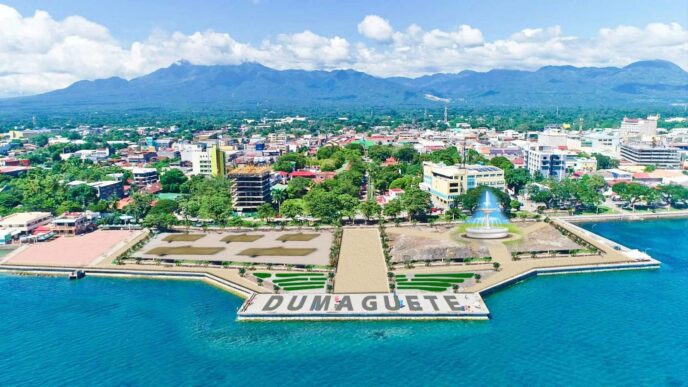By Danielle Bonior and Lealina Reyes
Let’s bury life—smother it under cement, blanket it with silt. Let’s do it gradually—project by project—until the fish vanish, the invertebrates perish, and local small fisherfolk cast their nets and come up empty. Until the marine life of Dumaguete is buried in the past.
This has happened in Escaño beach, the Dumaguete-Sibulan airport, Rizal boulevard, and currently along the shores of Barangays Looc and Piapi through the on-going shoreline protection project of the city. But what if it happens to the last beach in Dumaguete—Silliman University (SU) Beach?
The “Dumaguete Road Alignment Project,” set for implementation by DPWH Region 7, proposes a coastal road that would cut through SU Beach—a burgeoning threat to deface one of Dumaguete’s last publicly accessible sandy frontiers. The sands where turtles nest, where students meet between classes, where children and researchers wade through the same tide—gone.
Silliman University was awarded rights to SU Beach under a foreshore lease agreement (FLA) in 1995. Those rights expired in 2020 after 25 years, but the university continued paying the lease until 2022. Without it, the legal claim weakens—and the beach becomes fair game for any “public works” project dressed in the language of progress. If Silliman resumes lease payments and completes the necessary paperwork, the rights to the beach can still be asserted—but clearances from DPWH are needed to move forward. The longer the delay, the more vulnerable the beach becomes.
SU Beach—polluted, yes, but still alive—is where the university’s identity as the “Campus by the Sea” manifests beyond marketing at present day. It is a living campus.
Geographically, it forms part of the 8-kilometer stretch classified as the Southern Negros Marine Key Biodiversity Area (MKBA), a coastal zone teeming with life: over 200 species of fish, 200 types of coral, 100 macroinvertebrates, seven kinds of seagrass, and at least 20 threatened and 60 near-threatened species, according to research conducted by the Institute of Environmental and Marine Sciences (IEMS). Endangered life forms still persist here—within and around four marine reserves interwoven with active fishing areas.
For students of IEMS, SU Beach is crucial to their program. “Silliman Beach is our lab,” says IEMS Vice Governor Ted Bradshaw. “That’s where 90% of our learning comes from. We take water quality samples, we do assessments, we test for rugosity.” He stressed the importance of the beach coming into play as early as their first year in the program. In the midst of armchairs and theories, a minute’s walk is all it takes to apply and practice all they learned.
“We have access to basically all the organisms, families of organisms and the genuses we talk about. We’re able to find samples of them at SU beach,” Ted shared. The beach also serves as a place where studies and theses are conducted by IEMS seniors since almost any interest about marine life and their samples can be found around the area.
Beyond academic concerts, the proposed desecration of SU Beach is also a question of identity. IEMS, formerly known as the Silliman Marine Laboratory, was founded by the late National Scientist Dr. Angel Alcala. The facility was built in the name of marine conservation. “The legacy of Dr. Alcala and all the work he’s done, if we stand to lose the legacy, what does it say about us if SU beach is able to be paved over?” Ted raised.
SU beach is not only a place of importance for the academic community but also for the people whose livelihood is dependent on it. Spending much time in the area, IEMS has developed a very close-knit relationship with the fisherfolk who use the beach in their daily lives. “They are good people and they stand to lose a big chunk of their livelihood. So that’s hundreds of people who are going to need something else,” Ted stated.
In 2021, SU’s Board of Trustees made their position clear: “Reclamation projects will cause damage and disruption of marine ecosystems not only in Dumaguete City, but also in adjoining areas.” Their warning cited the very beach now under threat: SU Beach, already showing signs of erosion after the airport runway’s extension into the sea.
Action should no longer be only an option, but an expectation. Now, the only question left is what will finally push us to act.
According to SU Student Government (SUSG) Vice President Timmy Burbano, the answer isn’t passivity. “The SUSG has never been scared to stand up against oppressive moves such as this,” he shares. “With the culture we’ve normalized in SG, I trust that anyone who becomes a part of it will not hesitate to join protests and other initiatives that would help in compelling the LGU (Local Government Unit) and the community to scrap this proposal.”
SUSG has also sent a letter to the Office of the President to inquire about the issue at hand and make sure that the university secures an FLA to reassume autonomy on SU beach. The student body is already organizing—promoting solidarity across student organizations, spreading information, and preparing to act when the project moves forward. “It all starts with informing the student body and making sure that we have a unitary stand,” Burbano explains. “Rest assured, we are ready to mobilize.”
That unity is not for appearance or recognition, it is a commitment to collective responsibility. Silliman students have disrupted development plans before: a past SUSG laid down on Rizal Boulevard to stop expansion pre-2000’s. Sillimanians loudly stood against the 174-hectare reclamation until the project was halted. Protest, here, is not unfamiliar. It’s a pattern and a deliberate choice—a line drawn when values are on the brink.
If we slip into complacency, the gate that once opened to the sea will open to asphalt roads—its crashing waves, once a welcome to every Sillimanian, buried beneath concrete and drowned out by the roar of passing traffic.
One day, future students will walk past that same gate, not to study marine life, but to cross a highway. The campus by the sea will live on only in memory, replaced by a campus that turned its back on the very coast that shaped it.












